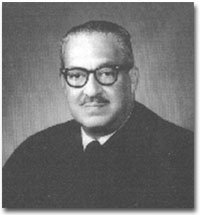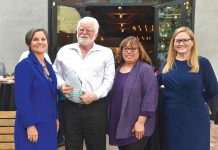Thurgood Marshall, a noted civil rights leader, was frequently
threatened by lynch mobs when he worked as Chief Counsel of the
National Association for the Advancement of Colored People.
Thurgood Marshall, a noted civil rights leader, was frequently threatened by lynch mobs when he worked as Chief Counsel of the National Association for the Advancement of Colored People. He headed the team of lawyers who successfully argued for school desegregation in the crucial Brown v. Board of Education case of 1954.
Marshall was appointed to the federal bench in 1961 and became the first African American justice on the U.S. Supreme Court in 1967. He died in 1993.
Recently, an Episcopal parish that he attended in Washington, D.C., petitioned the Diocese of Washington to begin the process to have his name commemorated in “Lesser Feasts and Fasts,” the church’s calendar of saints.
What is a saint and how does one become one? The word comes from the Latin “sanctus” for “holy.” Saints are people recognized as being holy. In the New Testament, this term was applied to all Christians. Paul wrote one of his letters “to the saints who are in Ephesus …”
Soon, though, the term began to be restricted to Christians who died, especially those who had been martyred or had shown extraordinary virtue in their lives. Each community had its own list of such people who received the endorsement of the local bishop.
The number of people so recognized began to proliferate, and in the 10th century Pope John XV reserved to himself the final approval of candidates for sainthood in the Roman Church. Soon a very involved procedure developed to grant this recognition.
The process, used today, involves two careful investigations: one where the candidate lived, and another in Rome, to examine the candidate’s life, writings and any miracles performed. A “devil’s advocate” is appointed to present counter evidence.
Finally, if the investigations are successful, the candidate is declared by the Pope to be “beatified” or “blessed,” already residing in heaven in recognition of a saintly life and heroic virtue. If two miracles that are attributed to this person after beatification can be verified, the candidate can go on to sainthood. Father Junipero Serra, founder of the California Mission system, is still being considered for the last stage of sainthood.
The Eastern Orthodox churches have a simpler method for canonization, more like the one followed earlier in the West. A bishop has authority to declare a saint through issuance of a solemn proclamation. Thus, saints are more local and not necessarily recognized in other dioceses.
In the United States, the Episcopal Church authorized creation of a special book of prayers and Bible readings for use in commemorating the lives of heroic figures not recognized in the official “Book of Common Prayer.” Criteria for inclusion in “Lesser Feasts and Fasts” include “heroic loving and joyous faith in confessing Christ, even to the point of risking one’s life, service to others for Christ’s sake, demonstrated devotion to prayer, and recognition of the faithful beyond the person’s local community.”
To add Marshall’s name, his case must be approved in two successive votes by the Church’s highest governing body, the General Convention, which meets every three years. Then his name would join the ranks of such contemporary Episcopal saints as Martin Luther King Jr. (April 4) and Florence Nightingale (May 18), who also have days set aside in their memory.













